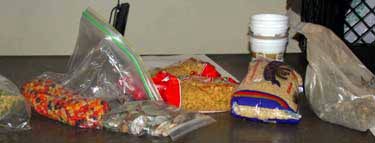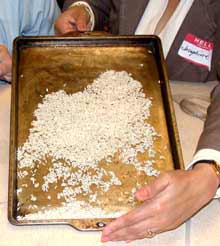return to
Potential to Kinetic
Classroom activity:
The Whoosh Factor
Purpose:
Students will use a model to investigate the factors involved in landslides.
Materials:
|
Baking tray Materials to whoosh, including rice Ruler/protractor |
 |
 |
Optional Materials: Macaroni, beans, shells |
Procedures:
|
 |
-
Average whoosh for rice: _____________
-
Discuss the factors involved in the whoosh.
Surface texture
Height/angle/slope
Size, shape, and density of materials -
You will have the opportunity to test the "whoosh factor" of at least three other materials. What kind of a hypothesis might you make? What do you predict will happen? Write down your hypothesis(ses) and then carry out your experiments. Record your results.
Hypothesis:
Materials selected to whoosh:
Results:
-
Revise your original hypthesis as appropriate, according to your results.
Results from teacher teams:
Hypotheses were made, tested, and in some cases revised as shown below:
-
As the mass of the materials increases, the angle of whoosh will also increase. The results supported this hypothesis.
-
As the size of the materials decreases, the angle of whoosh will increase. The results did not support this hypothesis. Shape of the materials pieces seemed to be a greater factor.
-
If a mixture of materials is used, the more irregularly shaped materials will get caught within the others and therefore will slide less easily. The results did not support this hypothesis.
-
If the material is of the same kind (e.g., all macaroni) then the greater the contact area with the surface, the greater the angle will be before the whoosh. The results appeared to support this hypothesis.
NOTE: One team mixed all of their materials together and the whoosh factor turned out to be the average of the whoosh factor of the individual materials!!!
Click here for a text only, student version of this activity.
Return to: Potential to Kinetic | Dynamic Earth Homepage | UCMP Homepege